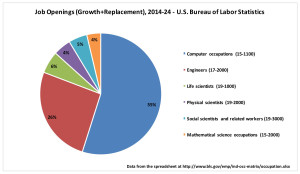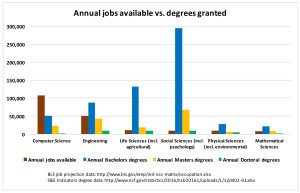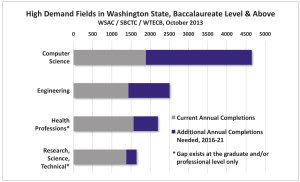The following is a guest blog post from Ed Lazowska, Bill & Melinda Gates Chair in Computer Science & Engineering at the University of Washington and Founding Chair of the Computing Community Consortium (2007-2013).
The 2016 U.S. Bureau of Labor Statistics (BLS) job projections have recently been released, covering the decade 2014-2024. As in all recent BLS projections, computing occupations dominate STEM: computing occupations are projected to account for 73% of all newly-created STEM jobs during the decade (488,500 jobs), and 55% of all available STEM jobs, whether newly-created or available due to retirements (1,083,800 jobs over the decade).
Of course, there are asterisks associated with any projection. And there are double asterisks associated with any interpretation of projections (for example, being a health care provider is not considered a STEM occupation). But no matter how you choose to slice it or dice it, the message is clear there is a lot of opportunity in computing. The BLS data is available here.
The 2016 NSF Science & Engineering Indicators have also been recently released, including data on the numbers of degrees granted in various STEM fields in 2013. A comparison of projected jobs available, annualized (from BLS) to degrees granted (from NSF) is sobering. Again, asterisks abound – for example, any higher ed degree is better than no higher ed degree, and many individuals work in fields unrelated to the name of their degree. The source data for the BLS job projection is available here and the S&E indicators degree data is available here.
Every state has its own version of this story. In my own state – Washington – three public agencies conducted a careful analysis two years ago attempting to identify all fields (not just STEM fields) in which there was a significant annual gap between degrees granted and job openings. They found only four such fields at the bachelors and graduate level. Computing occupations led the pack, with a gap 2.5 times as large as the second-place field – which was all fields of engineering combined. A separate study, just now being concluded, has found that Washington’s aerospace industry employs four times as many software professionals as aerospace engineers!
Looks like we picked the right field!














Trackbacks /
Pingbacks